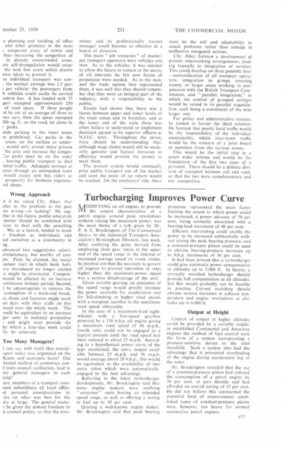Turbocharging Improves Power Curve
Page 69

If you've noticed an error in this article please click here to report it so we can fix it.
MODIFYING art oil engine, to provide the output characteristics of a petrol engine around peak revolutions without raising the maximum power, was the main theme of a talk given by Mr. P. A. C. Brockington. of The Commercial Moor. to the Industrial Transport Association's Birmingham Division, last week. After outlining the gains derived from employing close gear ratios at the upper end of the speed range in the interest of increased average speed on trunk routes, he pointed out that the necessity to govern oil engines to. prevent operation at rates higher than the maximum-power speed was, a serious disadvantage of the unit.
Given suitable gearing, an extension of the speed range would greatly increase the power available for acceleration and for hill-climbing at higher road speeds with a marginal sacrifice in the maximum road speed obtainable.
In the case of a maximum-load eightwheeler with a five-speed gearbox powered by a 150 b.h.p. oil engine giving a maximum road speed of' 40 m.p.h., fourth ratio could not he engaged in a typical instance until the road speed had been reduced to about 25 m.p.h. According to a hypothetical power curve of the type mentioned, the extra output available between 25 m.p.h. and 36 m.p.h. would average about 20 b.h.p.; this would be equivalent to the availability of two extra ratios which were automatically engaged to the best advantage.
Referring to the latest turbocharger developments, Mr. Brockington said that some engine makers were evolving "economy" units having an extended speed range, as well as offering a saving in fuel up to 10 per cent.
Quoting a well-known engine maker. Mr. Brockington said that peak bearing pressures represented the main factor limiting the extent to which power could be increased, a power advance of 70 per cent, being normally associated with a bearing-load increment of 40 per cent.
Efficient intercooling could enable the power to be increased substantially without raising the peak bearing pressure, and a constant-pressure piston could be used to obviate hearing-pressure increases up to b.h.p. increments of 30 per cent.
It had been proved that a turbocharger could give automatic power compensation at altitudes up to 5,000 ft. In theory, a correctly matched turbocharger should provide full compensation at all altitudes. but this would probably not be feasible in practice. Correct matching should obviate serious increases in exhaust temperature and engine revolutions at altitudes tip to 6,000 ft.
Output at Height
Control of output at higher altitudes could be provided by a variable nozzle: in established Continental and American engines the method of fuel control took the form of a system incorporating a pressure-sensitive device in the inlet manifold. Such a system also had the advantage that it prevented overloading of the engine during acceleration lag of the rotor.
Mr. Brockington revealed that the use of a constant-pressure piston had reduced the consumption of a petrol engine by 30 per cent, at part throttle and had afforded an overall "sa.)/ing of 15 per cent. He did not believe this represented the potential limit of improvement: established types of constant-pressure piston were, however, too heavy for normal automotive petrol engines.




















































































































